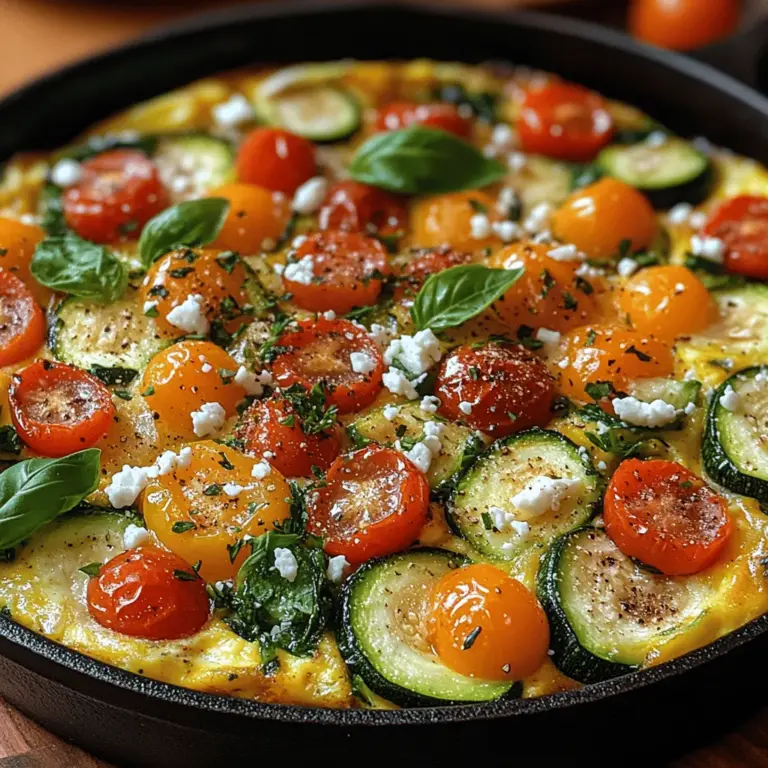Introduction
As the days grow longer and the sun shines brighter, there’s nothing quite like embracing the flavors of summer with a delicious and nutritious frittata. This versatile dish, often celebrated for its rich flavors and vibrant colors, brings together the very best of the season’s bountiful produce. A frittata can easily transition from a leisurely brunch with friends to a quick weekday lunch or even a light dinner, making it a staple in any culinary repertoire. Its simplicity in preparation allows both novice cooks and seasoned chefs to whip up a delightful meal with minimal effort.
The Sun-Kissed Summer Garden Frittata embodies the essence of summer with its array of fresh ingredients that burst with flavor. Imagine the tender crunch of zucchini, the sweetness of cherry tomatoes, and the bright, peppery notes of fresh basil coming together in a warm, comforting dish. Not only is this frittata a feast for the eyes, but it’s also packed with nutrients, making it a guilt-free indulgence. Whether you’re hosting a weekend brunch, looking for a quick meal, or simply wanting to celebrate the season’s produce, this frittata is sure to impress.
The Allure of Frittatas
At its core, a frittata is an Italian dish similar to an omelet, but with a few key differences that set it apart. Traditionally, frittatas have their ingredients mixed directly into the eggs rather than being folded inside like an omelet. This cooking method allows for a beautiful, golden crust to form on the bottom while keeping the inside soft and fluffy. The origins of the frittata can be traced back to Italy, where it was initially created as a way to use up leftover ingredients. Over time, it has evolved into a beloved dish enjoyed around the world.
What makes frittatas especially appealing is their incredible versatility. You can customize them in countless ways, incorporating various vegetables, meats, or cheeses based on your personal preferences or what you have on hand. They can be served warm, at room temperature, or even cold, making them perfect for any occasion—be it breakfast, brunch, lunch, or dinner.
In terms of nutrition, frittatas offer a wealth of benefits. The primary ingredient, eggs, is an excellent source of high-quality protein, essential for muscle repair and overall health. When paired with a bounty of fresh vegetables, a frittata becomes a colorful plate packed with vitamins and minerals. For example, spinach is a nutritional powerhouse, rich in iron and antioxidants, while zucchini provides hydration and dietary fiber. Together, these ingredients create a well-rounded meal that nourishes the body and satisfies the taste buds.
Ingredients Breakdown
Creating a Sun-Kissed Summer Garden Frittata requires a handful of fresh, vibrant ingredients, each contributing its unique flavor and nutritional profile. Let’s dive into the key components that make this dish truly shine:
– Eggs: The foundation of any frittata, eggs provide a rich source of protein and healthy fats. They create a fluffy texture when cooked and serve as the binding agent for all the other ingredients.
– Milk or Cream: Adding a splash of milk or cream enhances the creaminess of the frittata. It helps to create a tender, custard-like consistency that elevates the overall mouthfeel.
– Zucchini: This summer squash is not only low in calories but also high in vitamins A and C. Zucchini adds moisture and a subtle sweetness, making it a perfect addition to the frittata.
– Cherry Tomatoes: Bursting with flavor, cherry tomatoes provide a delightful sweetness that balances the savory elements of the dish. Their acidity complements the richness of the eggs beautifully.
– Fresh Spinach: Packed with nutrients, fresh spinach adds a vibrant green color and a boost of iron and fiber. It wilts down during cooking, integrating seamlessly into the frittata.
– Bell Pepper: Available in various colors, bell peppers add a crunchy texture and a hint of sweetness. They also provide vitamin C, enhancing the nutritional value of the dish.
– Red Onion: Known for their aromatic quality and subtle sweetness, red onions bring depth of flavor to the frittata. Their color also adds visual appeal.
– Feta or Goat Cheese: Either of these cheeses brings a creamy texture and tangy flavor to the frittata. Feta’s distinctive taste enhances the overall flavor profile, while goat cheese adds a smooth richness.
– Fresh Basil: This aromatic herb infuses the frittata with a fresh, herby flavor that perfectly complements the summer vegetables. Basil also provides anti-inflammatory properties.
– Olive Oil: A healthy fat, olive oil is essential for sautéing vegetables and adds richness to the dish. Its heart-healthy properties make it a great choice for cooking.
– Salt and Pepper: These basic seasonings are critical for enhancing the flavors of the ingredients. A pinch of salt and a dash of pepper bring out the best in every component of the frittata.
Step-by-Step Cooking Instructions
Now that we’ve gathered all the vibrant ingredients for our Sun-Kissed Summer Garden Frittata, it’s time to begin the cooking process. The first step is preheating the oven, a crucial part of achieving the perfect frittata.
Preheating the Oven
Preheating the oven is an essential step that should never be overlooked. By setting your oven to the correct temperature—typically around 375°F (190°C)—you ensure that the frittata cooks evenly and thoroughly. A preheated oven allows the frittata to rise beautifully and develop that delightful golden crust on the top, while the inside remains soft and fluffy.
Once your oven is preheated, it’s time to move on to the next steps in crafting this delightful dish, where the vibrant colors and fresh flavors of summer come together in a harmonious blend.
Stay tuned for the detailed cooking instructions that will guide you through each step of creating your Sun-Kissed Summer Garden Frittata, ensuring a delicious result that celebrates the spirit of summer.
Preparing the Egg Mixture
To achieve the perfect frittata, the egg mixture plays a pivotal role. Start with large, fresh eggs; the quality of your eggs directly influences the flavor and texture of the dish. Crack the eggs into a large mixing bowl and whisk them vigorously. Incorporate a splash of milk or cream to add richness and enhance the fluffiness of your frittata. For optimal results, aim for a ratio of about one tablespoon of milk per egg. This small addition helps create a smooth, airy texture.
When whisking, ensure that you beat the eggs until they are fully combined and slightly frothy. This introduces air into the mixture, which is key for achieving a light and fluffy frittata. Season your eggs generously with salt and pepper; this base seasoning is crucial as it enhances the overall flavor of the dish. If you want to elevate the taste further, consider adding a pinch of your favorite herbs or a dash of hot sauce for a subtle kick.
Sautéing the Vegetables
The next step in creating a Sun-Kissed Summer Garden Frittata is sautéing your chosen vegetables. Proper cooking techniques can significantly enhance the flavor profile of your frittata. Start by heating a generous drizzle of olive oil in a large, oven-safe skillet over medium heat. This is where you can begin to layer your flavors.
Add your chopped vegetables, starting with the denser ones such as bell peppers, onions, or zucchini. Sauté them for about 3-4 minutes until they start to soften. Follow with softer vegetables like tomatoes or spinach, which require less cooking time. Aim for a vibrant color and a tender texture without overcooking, as this can lead to a mushy frittata. Stir occasionally and season with salt, pepper, and your preferred herbs to enhance their natural flavors. The key is to cook the vegetables just enough to develop their sweetness while retaining their shape and nutritional benefits.
Combining Ingredients
Once your vegetables are sautéed to perfection, it’s time to combine them with the egg mixture. Pour the whisked eggs directly over the sautéed vegetables in the skillet. Gently lift the cooked vegetables with a spatula to ensure the egg mixture permeates evenly. This layering technique allows the flavors to meld while ensuring that the frittata cooks uniformly.
At this stage, if you’re adding cheese, sprinkle it evenly across the top of the mixture. Cheese not only adds flavor but also helps bind the ingredients together, creating a deliciously creamy texture. Be mindful of how much cheese you add; too much can overpower the frittata and result in an overly dense dish.
Cooking on Stovetop
To set the base of your frittata, cook it on the stovetop for a few minutes before transferring it to the oven. Use medium-low heat and cover the skillet with a lid. This method traps steam and helps the eggs cook evenly. As the frittata cooks, you’ll notice the edges begin to set while the center remains slightly runny. This is a good sign, as the frittata will continue to cook in the oven.
Check the frittata occasionally, gently lifting the edges to allow any uncooked egg to flow underneath. This technique ensures that the bottom doesn’t burn while the top remains undercooked. Aim for a silky texture, where the frittata is just firming up without being fully cooked through.
Baking in the Oven
Preheat your oven to 350°F (175°C) while the stovetop cooking is happening. Once the edges of your frittata have set, transfer the skillet to the preheated oven. Bake for about 15-20 minutes or until the frittata is puffed and the center is fully set. The top should be slightly golden and firm to the touch. This finishing step not only cooks the frittata through but also gives it a beautiful, appetizing appearance.
Keep a close eye on the frittata to prevent overcooking. An overbaked frittata can become dry and lose its delightful texture. When it’s ready, remove it from the oven and let it rest for a few minutes before slicing. This resting time allows the frittata to firm up slightly, making it easier to cut and serve.
Cooling and Serving
Cool your Sun-Kissed Summer Garden Frittata for about 5-10 minutes on a wire rack. This step is crucial for maintaining a perfect texture and preventing it from becoming soggy when served. You can slice the frittata into wedges or squares depending on your serving preference.
For a casual brunch or picnic, serve the frittata at room temperature alongside a fresh green salad or crusty bread. If you’re hosting a more formal gathering, consider plating it hot with a garnish of fresh herbs or a dollop of crème fraîche on top. This not only enhances the dish’s appearance but also adds a creamy contrast to the savory frittata.
Flavor Variations and Substitutions
One of the joys of making a frittata is the versatility it offers. Feel free to experiment with seasonal vegetables depending on what’s available. Spinach, kale, asparagus, or even seasonal squash can be delicious substitutes or additions. The key is to aim for a balance of textures and flavors.
When it comes to cheese, there are many alternatives to consider. If you’re looking for a dairy-free option, try using cashew cheese or nutritional yeast for a cheesy flavor without the dairy. For those who enjoy a bold flavor, feta or goat cheese can provide a tangy contrast to the sweetness of the vegetables.
Herb variations can also elevate your frittata. While basil and parsley are classic choices, consider using dill, thyme, or chives for an entirely different flavor profile. Fresh herbs add a burst of freshness and can transform the dish with minimal effort.
Nutritional Information
Understanding the nutritional value of your Sun-Kissed Summer Garden Frittata is important for maintaining a balanced diet. Each serving (1/8 of the frittata) typically contains approximately:
– Calories: 180-220
– Protein: 10-12 grams
– Fats: 12-15 grams (depending on cheese and oil used)
– Carbohydrates: 5-7 grams
This dish is packed with protein from the eggs, which are not only a great source of energy but also contain essential vitamins such as B12, D, and A. The vegetables contribute vital minerals and fiber, promoting digestive health and overall well-being.
Serving Suggestions
To complement your frittata, consider pairing it with a light salad drizzled with vinaigrette for a refreshing contrast. Roasted potatoes or a side of grilled asparagus also make excellent accompaniments. For a more substantial meal, serve it alongside whole-grain toast or a breakfast burrito.
As for beverages, a chilled glass of freshly squeezed orange juice pairs beautifully, or opt for a light sparkling wine for a touch of elegance. If you prefer something warm, a cup of herbal tea or coffee can round out the meal nicely.
Storing and Reheating Leftovers
Should you have any leftovers, storing your frittata properly is key to preserving its flavor and texture. Allow it to cool completely before transferring it to an airtight container. It will keep well in the refrigerator for up to 4 days. For longer storage, you can freeze slices of frittata wrapped tightly in plastic wrap, followed by aluminum foil, for up to 2 months.
When it comes to reheating, the best method is to warm the frittata in the oven at 350°F (175°C) for about 10-15 minutes, or until heated through. This method helps maintain its fluffy texture. You can also reheat slices in the microwave, but be cautious not to overheat, as this can lead to a rubbery texture.
Conclusion
Crafting a Sun-Kissed Summer Garden Frittata is a delightful way to celebrate the vibrant flavors of summer while enjoying a nutritious meal. The beautiful colors and rich textures make it an appealing dish for any occasion, from casual brunches to elegant dinners.
Encourage your creativity by experimenting with different ingredient combinations, allowing the frittata to reflect your personal taste. Whether you choose to stick with traditional vegetables or explore new seasonal offerings, this dish promises to be a go-to staple in your kitchen. Celebrate the joy of cooking with fresh ingredients and enjoy the process of creating this healthy, delicious frittata that captures the essence of summer in every bite.



